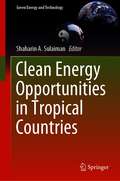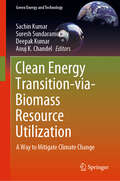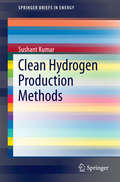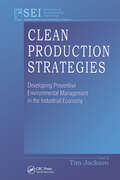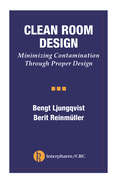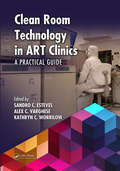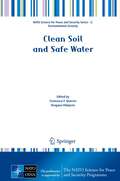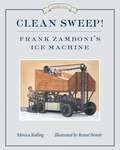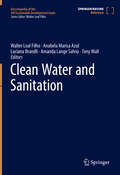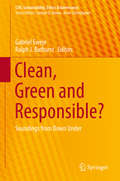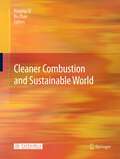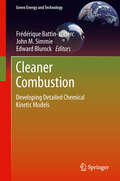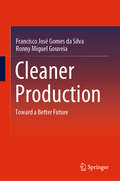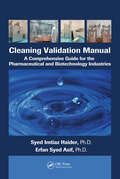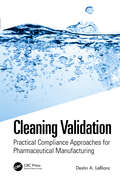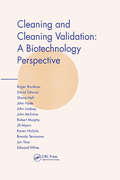- Table View
- List View
Clean Energy Investments for Zero Emission Projects: An Analysis on How to Reduce the Carbon Footprint (Contributions to Management Science)
by Hasan Dinçer Serhat YükselThis contributed volume analyses and discusses how atmospheric carbon emissions can be prevented using carbon capture and removal technology and how renewable energies can be used to reduce carbon emissions. Both approaches have their disadvantages. First of all, both involve high costs. Secondly, both require the use of advanced technology. As a result, many countries continue to use fossil fuels. The book seeks to address these problems by identifying strategies to increase countries’ use of clean energy. The authors discuss the dilemmas of zero emission and competition in the energy industry and illustrate cross-country applications of the current trends in the form of zero-emission business projects.
Clean Energy Opportunities in Tropical Countries (Green Energy and Technology)
by Shaharin A. SulaimanThis book highlights the present scenario of energy demand and power generation technologies in tropical countries. The tropics are well known to receive direct sunlight. Furthermore, different than four-season countries, tropical countries have a continuous summer-like season, and therefore, they are rich in clean energy sources, like solar and biomass. Home to 40% of the world’s population, the demand for energy in these countries keeps increasing. With the present serious global concern on the environment, the choice of power generation is no doubt the cleanest possible resources. This book delves into the opportunity that various tropical countries have in pursuing environmentally friendly power generation systems.
Clean Energy Transition-via-Biomass Resource Utilization: A Way to Mitigate Climate Change (Green Energy and Technology)
by Deepak Kumar Anuj K. Chandel Sachin Kumar Suresh SundaramurthyThis book highlights clean energy transition via sustainable utilization of biomass resources, viz. forestry, agriculture, agroforestry, grassland, and seaweeds to climate change mitigation. Bioresources have tremendous potential to mitigate global warming. Also, biomass is expected to play a multifunctional role including food production, source of energy and fodder, biodiversity conservation, and yield of goods and services to the society. It brings together perspectives of various communities involved in the research and regulation of bioenergy deployment in the context of climate change mitigation. The book presents the way forward to policy makers and stakeholders involved with bioenergy development. This development may be directive challenges in the transport sector where options such as hydrogen and electric vehicles relying on hydro, wind, and solar PV will require decades to become established on a substantial scale. Furthermore, meeting ambitious climate change targets will also require environment-friendly fuels in air and marine transport where no alternative to biofuels is currently available. The process design-via-onion model for sustainable utilization of biomass resources is also one of the most important subjects of the book. This book includes state-of-the-art approaches on bottlenecks and circular economy analysis for biomass energy use to reduce climate change and sustainability frameworks to guide bioenergy development.
Clean Hydrogen Production Methods (SpringerBriefs in Energy)
by Sushant KumarThis brief covers novel techniques for clean hydrogen production which primarily involve sodium hydroxide as an essential ingredient to the existing major hydrogen production technologies. Interestingly, sodium hydroxide plays different roles and can act as a catalyst, reactant, promoter or even a precursor. The inclusion of sodium hydroxide makes these processes both kinetically and thermodynamically favorable. In addition possibilities to produce cleaner hydrogen, in terms of carbon emissions, are described. Through modifications of steam methane reformation methods and coal-gasification processes, from fossil as well as non-fossil energy sources, the carbon dioxide emissions of these established ways to produce hydrogen can significantly be reduced. This brief is aimed at those who are interested in expanding their knowledge on novel techniques and materials to produce clean hydrogen and capture carbon dioxide at a large-scale. The detailed thermodynamic analysis, experimental findings and critical analysis of such techniques are well discussed in this brief. Therefore, this book will be of great interest and use to students, engineers and researchers involved in developing the hydrogen economy as well as mitigating carbon dioxide emissions at a large-scale.
Clean Production Strategies Developing Preventive Environmental Management in the Industrial Economy
by Tim JacksonClean Production Strategies is a cross-disciplinary book that presents a comprehensive examination of a new ethic emphasizing the appropriate design of products, processes, and economic activities to reduce the generation of waste into the environment. The book explores concepts and principles, technological issues, economic implications, the development of policy, and broad social questions associated with implementing clean production strategies. Written by a team of international experts in the field, Clean Production Strategies covers a wide range of topics, including principles of thermodynamics, quantitative assessments of material flows, the development of practical clean technologies, and the re-evaluation of our relationship with the environment. The book will be useful to government policy-makers, industrial decision-makers, plant managers, industrial engineers, economists, environmentalists, international regulatory agency personnel, and others interested in the topic.
Clean Room Design: Minimizing Contamination Through Proper Design
by Bengt Ljungqvist Berit ReinmullerThis practical book provides detailed guidance on all aspects of clean room airflow, the mechanics of airflow, and how microbial contamination is carried. Ljungqvist and Reinmüller draw on years of experience in clean room design and operation. The book contains maps of the effect of human interference on unidirectional airflow and the potential for contamination. Particle challenge test methods and tracer gas detection methods are explained, and the impact and interpretation of the results obtained from these test methods are discussed.Topics include: o Dispersion of Airborne Contaminants o Contamination Riskso Wakes (including factual situations)o Open, Unidirectional Air Flow Benches (laminar flow benches)o Microbiological Assessmento Weighing Stationso Air Flow Through Openingso Mathematical Treatment of Contamination Riskso Simulation of Air Flows & Dispersion of Contaminants through Doorways in a Suite of Clean Rooms o Regulatory Requirements
Clean Room Technology in ART Clinics: A Practical Guide
by Alex C. Varghese Sandro C. Esteves Kathryn C. WorrilowRegulatory agencies worldwide have issued directives or such requirements for air quality standards in embryology laboratories. This practical guide reviews the application of clean room technology or controlled environments specifically suited for Assisted Reproductive Technology (ART) Units. Its comprehensive coverage includes material on airborne particles and volatile organic compounds, including basic concepts, regulation, construction, materials, certification, clinical results in humans, and more.
Clean Soil and Safe Water (NATO Science for Peace and Security Series C: Environmental Security)
by Dragana Vidojevic Francesca F. QuerciaThis book addresses questions of relevance to governments and industry in many countries around the world, in particular concerning the link between contaminated-land-management programs and the protection of drinking water resources and the potential effects of climate changes on the availability of these same resources. On the "problem" side, it reports and analyzes methodologies and experiences in monitoring and characterization of drinking water resources (at basin, country and continental scales), pollution prevention, assessment of background quality and of impacts on safety and public health from land and water contamination and impacts of climate change. On the "solution" side, the book presents results from national cleanup programs, recent advances in research into groundwater and soil remediation techniques, treatment technologies, research needs and information sources, land and wastewater management approaches aimed at the protection of drinking water.
Clean Sweep! Frank Zamboni's Ice Machine: Great Idea Series (Great Idea Series #8)
by Monica KullingWhen Frank Zamboni, along with his brother and cousin, opened their own skating rink in 1940 in Paramount, California, it could take an hour and a half for a crew to resurface the ice. They had to level the surface by shaving down the pits and grooves with a tractor, remove the shavings, wash the ice and find a way to give the rink its shining finish. Skaters became exasperated with the wait, so Frank was determined to do something about it. Could he turn a ninety-minute job for five men into a ten-minute task for only one? Working in the shed behind his ice rink, Frank drew designs and built models of machines he hoped would do the job. For nine years, he worked on his invention, each model an improvement on the one before. Finally, in 1949, Frank tested the Model A, which "cleaned the ice in one sweep around the rink." The rest is history.
Clean Water and Sanitation (Encyclopedia of the UN Sustainable Development Goals)
by Walter Leal Filho Tony Wall Luciana Brandli Anabela Marisa Azul Amanda Lange SalviaThe problems related to the process of industrialisation such as biodiversity depletion, climate change and a worsening of health and living conditions, especially but not only in developing countries, intensify. Therefore, there is an increasing need to search for integrated solutions to make development more sustainable. The United Nations has acknowledged the problem and approved the “2030 Agenda for Sustainable Development”. On 1st January 2016, the 17 Sustainable Development Goals (SDGs) of the Agenda officially came into force. These goals cover the three dimensions of sustainable development: economic growth, social inclusion and environmental protection. The Encyclopedia of the UN Sustainable Development Goals comprehensively addresses the SDGs in an integrated way. It encompasses 17 volumes, each devoted to one of the 17 SDGs. This volume is dedicated to SDG 6 "Ensure availability and sustainable management of water and sanitation for all". Water and sanitation are fundamental to human well-being. Integrated water resources management is essential to ensure availability and sustainable management of water and sanitation for all and to the realization of Sustainable Development.Concretely, the defined targets are:Achieve universal and equitable access to safe and affordable drinking water for allAchieve access to adequate and equitable sanitation and hygiene for all and end open defecation, paying special attention to the needs of women and girls and those in vulnerable situationsImprove water quality by reducing pollution, eliminating dumping and minimizing release of hazardous chemicals and materials, halving the proportion of untreated wastewater and substantially increasing recycling and safe reuse globallySubstantially increase water-use efficiency across all sectors and ensure sustainable withdrawals and supply of freshwater to address water scarcity and substantially reduce the number of people suffering from water scarcity Implement integrated water resources management at all levels, including through transboundary cooperation as appropriateProtect and restore water-related ecosystems, including mountains, forests, wetlands, rivers, aquifers and lakes Expand international cooperation and capacity-building support to developing countries in water- and sanitation-related activities and programmes, including water harvesting, desalination, water efficiency, wastewater treatment, recycling and reuse technologiesSupport and strengthen the participation of local communities in improving Uwater and sanitation managementEditorial BoardUlisses M. Azeiteiro, Anabela Marisa Azul, Luciana Brandli, Dominique Darmendrail, Despo Fatta–Kassinos, Walter Leal Filho, Susan Hegarty, Amanda Lange Salvia, Albert Llausàs, Paula Duarte Lopes, Javier Marugán, Fernando Morgado, Wilkister Nyaora Moturi, Karel F. Mulder, Alesia Dedaa Ofori, Sandra Ricart
Clean Water: Next Generation Technologies (Advances in Science, Technology & Innovation)
by Ahmad Fauzi Ismail Mohamed Mehdi Chehimi Mehmet A. Oturan Khouloud JlassiThis book summarises the recent, and future, sustainable, low-cost, environment-friendly and efficient systems for clean water production, to solve clean water crisis. We cover production of water the dew and rain or via desalination, Fenton processes or electrocoagulation; nanomaterial-based water purification methods including adsorption, catalysis, smart-sensors for pollutants detection and removal. We also cover environmental management, environmental policy aspects, and review recent patents and industrial processes to produce clean water. Written by experts in the domain of wastewater treatment, production of clean water and environmental management, this new book will be a unique tool for experts and students. We anticipate it open new horizons in clean water production and will be a source of inspiration for next generations of clean water technologies researchers
Clean, Green and Responsible?: Soundings from Down Under (CSR, Sustainability, Ethics & Governance)
by Gabriel Eweje Ralph J. BathurstNew Zealand and Australia are broadly considered to be countries in which sustainability and responsibility discourses are being pursued by governments and business alike, and in which incentives and initiatives are helping confront and overcome sustainability-related challenges. This book takes a closer look behind and beyond the marketing mantras of both Australia’s and New Zealand’s “clean and green” campaigns and, on the basis of representative examples and cases, critically evaluates the status quo.The book assesses the effectiveness of sustainability and responsibility models with a focus on the South Pacific and argues that the ways in which issues have been dealt with in this more closely defined geographical region are most likely a good indicator of how similar issues are (or soon will be) dealt with around the globe. As such, the book offers a rich source of cases on sustainability and responsibility in the business arena, a critical review, and an inspirational affirmation of responsible business practice.
Clean-In-Place for Biopharmaceutical Processes (Drugs and the Pharmaceutical Sciences)
by Dale A. SeiberlingAn invaluable source instruction on the principles, instrumentation, design, implementation, operation, and maintenance of an effective clean-in-place system (CIP), this guide illustrates best practices and successful applications of CIP in both pharmaceutical and biotechnology facilities. Offering reader-friendly descriptions of the various types
Clean: The New Science of Skin
by James HamblinA preventative medicine physician and staff writer for The Atlantic explains the surprising and unintended effects of our hygiene practices in this informative and entertaining introduction to the new science of skin microbes and probiotics. Keeping skin healthy is a booming industry, and yet it seems like almost no one agrees on what actually works. Confusing messages from health authorities and ineffective treatments have left many people desperate for reliable solutions. An enormous alternative industry is filling the void, selling products that are often of questionable safety and totally unknown effectiveness. In Clean, doctor and journalist James Hamblin explores how we got here, examining the science and culture of how we care for our skin today. He talks to dermatologists, microbiologists, allergists, immunologists, aestheticians, bar-soap enthusiasts, venture capitalists, Amish people, theologians, and straight-up scam artists, trying to figure out what it really means to be clean. He even experiments with giving up showers entirely, and discovers that he is not alone. Along the way he realizes that most of our standards of cleanliness are less related to health than most people think. A major part of the picture has been missing: a little-known ecosystem known as the skin microbiome—the trillions of microbes that live on our skin and in our pores. These microbes are not dangerous; they&’re more like an outer layer of skin that no one knew we had, and they influence everything from acne, eczema, and dry skin to how we smell. The new goal of skin care will be to cultivate a healthy biome—and to embrace the meaning of &“clean&” in the natural sense. This can mean doing much less, saving time, money, energy, water, and plastic bottles in the process.Lucid, accessible, and deeply researched, Clean explores the ongoing, radical change in the way we think about our skin, introducing readers to the emerging science that will be at the forefront of health and wellness conversations in coming years.
Cleaner Combustion and Sustainable World
by Bo Zhao Haiying QiCleaner Combustion and Sustainable World is the proceedings of the 7th International Symposium on Coal Combustion which has a significant international influence. It concerns basic research on coal combustion and clean utilization, techniques and equipments of pulverized coal combustion, techniques and equipments of fluidized bed combustion, basic research and techniques of emission control, basic research and application techniques of carbon capture and storage (CCS), etc. Professor Haiying Qi and Bo Zhao both work at the Tsinghua University, China
Cleaner Combustion: Developing Detailed Chemical Kinetic Models (Green Energy and Technology)
by Edward Blurock Frédérique Battin-Leclerc John M. SimmieThis overview compiles the on-going research in Europe to enlarge and deepen the understanding of the reaction mechanisms and pathways associated with the combustion of an increased range of fuels. Focus is given to the formation of a large number of hazardous minor pollutants and the inability of current combustion models to predict the formation of minor products such as alkenes, dienes, aromatics, aldehydes and soot nano-particles which have a deleterious impact on both the environment and on human health. Cleaner Combustion describes, at a fundamental level, the reactive chemistry of minor pollutants within extensively validated detailed mechanisms for traditional fuels, but also innovative surrogates, describing the complex chemistry of new environmentally important bio-fuels. Divided into five sections, a broad yet detailed coverage of related research is provided. Beginning with the development of detailed kinetic mechanisms, chapters go on to explore techniques to obtain reliable experimental data, soot and polycyclic aromatic hydrocarbons, mechanism reduction and uncertainty analysis, and elementary reactions. This comprehensive coverage of current research provides a solid foundation for researchers, managers, policy makers and industry operators working in or developing this innovative and globally relevant field.
Cleaner Production: Toward a Better Future
by Francisco José Gomes da Silva Ronny Miguel GouveiaThis book provides an overview of cleaner production, including how regulations have evolved, and presents a broad perspective on how it is being developed. Presenting several practical examples and applications of modern clean production technologies, it provides readers with ideas on how to extend these practices to other industry sectors in order to contribute to a better environment in the future.The authors start from the initial concepts of how to implement new cleaner production systems, before collecting recent developments in the area and demonstrating practical ways in which the latest knowledge can be applied. It motivates readers to develop new ideas on how to improve manufacturing systems to save energy and generate less waste, and discusses strategies on how to save, reuse and adapt materials, as well as techniques to reduce the waste and pollution produced.This book serves as a reference resource for industrial management engineers and researchers, and is also of interest to undergraduate and postgraduate students looking for insights into cleaner production in industry.
Cleaning Validation Manual: A Comprehensive Guide for the Pharmaceutical and Biotechnology Industries
by Syed Imtiaz HaiderDuring the past decades, enormous progress and enhancement of pharmaceutical manufacturing equipment and its use have been made. And while there are support documents, books, articles, and online resources available on the principles of cleaning and associated processing techniques, none of them provides a single database with convenient, ready-to-use training tools. Until now. Cleaning Validation Manual: A Comprehensive Guide for the Pharmaceutical and Biotechnology Industries elucidates how to train the man power involved in development, manufacturing, auditing, and validation of bio pharmaceuticals on a pilot scale, leading to scale-up production.With over 20 easy-to-use template protocols for cleaning validation of extensively used equipments, this book provides technical solutions to assist in fulfilling the training needs of finished pharmaceutical manufacturers. Drawing on the authors’ more than two decades of experience in the pharmaceutical and biotech industries, the text offers hands-on training based on current approaches and techniques. The book does not merely provide guidelines or thought processes, rather it gives ready-to-use formulas to develop Master Plan, SOPs, and validation protocols. It includes cleaning procedures for the most commonly used equipment in various manufacturing areas and their sampling points, using a pharmaceutical manufacturing site with both sterile and non-sterile operations as the case facility. It also provides the training guidelines on downloadable resources to enable users to amend or adopt them as necessary.Grounded in practicality, the book’s applicability and accessibility set it apart. It can be used as a guide for implementing a cleaning validation program on site without the help of external consultants, making it a resource that will not be found collecting dust on a shelf, but rather, referred to again and again.
Cleaning Validation: Practical Compliance Approaches for Pharmaceutical Manufacturing
by Destin A. LeBlancPharmaceutical manufacturers and upper management are encouraged to meet the challenges of the science-based and risk-based approaches to cleaning validation. Using some of the principles and practices in this volume will help in designing a more effective and efficient cleaning validation program. Features • Timely coverage of cleaning validation for the pharmaceutical industry, a dynamic area in terms of health-based limits. • The author encourages pharmaceutical manufacturers, and particularly upper management, to meet the challenges of the science-based and riskbased approaches to cleaning validation. • Draws on the author’s vast experience in the field of cleaning validation and hazardous materials. • Discusses EMA vs. ISPE on Cleaning Limits and revised Risk-MaPP for highly hazardous products in shared facilities. • A diverse list of topics from protocol limits for yeasts and molds to cleaning validation for homeopathic drug products.
Cleaning and Cleaning Validation: A Biotechnology Perspective
by Jon VossThis book is intended to serve as a source of practical, technicalinformation for those persons in the biotechnology industry. Casestudies and/ or actual industry examples are used to support the textwherever possible. While much of the material contained within thistext is equally applicable to nonbiopharmaceutical processes, theemphasis has been focused directly upon biopharmaceuticalmanufacturing.Section I provides an in-depth analysis of the design concepts thatlead to cleanable equipment. Also covered in the tirst section arecleaning mechanisms and cleaning systems. The first section isparticularly useful to those persons faced with the task of designingsystems that will be cleaned and also provides the biochemicaloockground of the mechanisms associated with the removal of commonbiotechnology soils.Section II focuses on cleaning validation concepts. While thematerial is equally useful for single product cleaning, emphasis isplaced upon multiproduct cleaning validation. Included in Section IIare general validation principles as thex apply to cleaning validation,detailed analxsis of cleaning process validation, sampling techniques,analytical methods and acceptance criteria. The material in this sectionwill be useful to anyone responsible for the development of a cleaningvalidation program.The final section, Section Ill, provides an overview of multiproductbiotechnology manufacturing procedures. Included in this section is ananalysis of tne risk-to-benefit scenarios associated with the various formsof product manufacturing, analysis of changeover programs, ~uipmentconsiderations, and material transfer systems as they are affected bymultiproduct manufacturing strategies.
Cleanroom Microbiology for the Non-Microbiologist
by David M. CarlbergWritten for the professional who has an immediate need for the information but has little or no training in the subject, Cleanroom Microbiology for the Non-Microbiologist, Second Edition introduces principles of microbiology. It explains the consequences of microbiological contamination, what contamination is all about, how microorganisms grow, and
Clear Home, Clear Heart: Learn To Clear The Energy Of People And Places
by Jean HanerHave you ever entered a room and it just didn’t feel right, yet you couldn’t explain why? Do you sense a natural comfort with some people but are immediately stressed by others? The truth is that we’re all influenced far more than we realize by the invisible energy of the people and places around us. This, along with difficult experiences in your past that still weigh you down, can keep you from being a creative force in your life. Clearing is a gentle but powerful way to release the old stress you’re still carrying from your life history, as well as transform how you’re affected by the energy around you each day. Many people experience immediate shifts in their energy during a clearing, and significant change often unfolds in the days and weeks afterward. In fact, clearing has even been described as “accelerated meditation” because it can lead to a sense of calm and happiness that typically results only after years of a mindfulness practice. In this simple, elegant guide, Jean Haner teaches you, in easy-to-follow steps, how to clear your own energy or that of any person, as well as bring harmony to the energy of the spaces you inhabit, so you can reclaim your vitality and joy, and open up infinite new possibilities in life. Healers, intuitives, energy workers, highly sensitive people, and anyone who just wants to optimize their energy and live their best life will find this to be the perfect training. Jean refines energy clearing to its pure essence—the power of the compassionate heart!
Clear Skies
by Jessica Scott KerrinAs the US/Soviet Space Race heats up in 1961, eleven-year-old Arno finds his dreams of becoming an astronomer exploding like an extragalactic supernova. It is the summer of 1961, and eleven-year-old Arno Creelman wants nothing more than to be an astronomer. His claustrophobia rules out flying in a cramped space capsule, so instead, Arno dreams of exploring the galaxies with powerful telescopes back on Earth. Arno’s first move: Enter a local radio contest and win a visit to the new observatory that is about to open near his town. The ribbon will be cut by Arno’s idol, Jean Slayter-Appleton, a renowned astronomer whose weekly columns Arno clips for his own notebooks. When he finally manages to phone in and correctly answer the skill-testing astronomy question, Arno is thrilled. Then a new boy moves to the neighborhood, and he seems to challenge Arno in every way. Robert even believes in astrology, which Arno argues is not a science at all. Before long, Arno is feeling left behind, on the outs with his friends and even abandoned by his beloved dog, Comet. How did Arno’s dream become a cosmic nightmare? Key Text Features illustrations Correlates to the Common Core State Standards in English Language Arts: CCSS.ELA-LITERACY.RL.4.3 Describe in depth a character, setting, or event in a story or drama, drawing on specific details in the text (e.g., a character's thoughts, words, or actions).
Cleared for Takeoff: The Ultimate Book of Flight
by Rowland WhiteAll of aviation's dangerous, exciting, and most courageous moments are featured within this stunning compendium on flight. Packed with stories of heroic and innovative pioneers, fascinating profiles of remarkable planes from Spitfires to space shuttles, and how-to instructions for making everything from origami helicopters to bottle rockets—all accompanied by sensational photographs, illustrations, and diagrams—Cleared for Takeoff promises to astonish, entertain, and fire the imaginations of everyone with their head in the clouds.
Clearing the Air in Los Angeles: The Fight Against Smog (Narrative)
by Carl R. OliverSolving the mystery of California's most persistent smog.Once known as the Smog Capital of the World, Los Angeles has changed "air you can see " into "air you can breathe ." While the fight to eliminate pollution in the city continues, modern smog is not the thick, oppressive, silver-blue haze that drove people to move out of Los Angeles altogether during the mid-twentieth century. Professor Arie Haagen-Smit became a key leader in the fight against smog after making a crucial discovery--what caused it. Join author Carl R. Oliver as he delves into the sixty-year battle to clear the air in Los Angeles.

